A knowledge of surface anatomy and its underlying structure has been a central tenet of figurative art throughout history. This is nowhere more evident than in the art of the Italian Renaissance, when man himself became an appropriate subject matter for works of art.
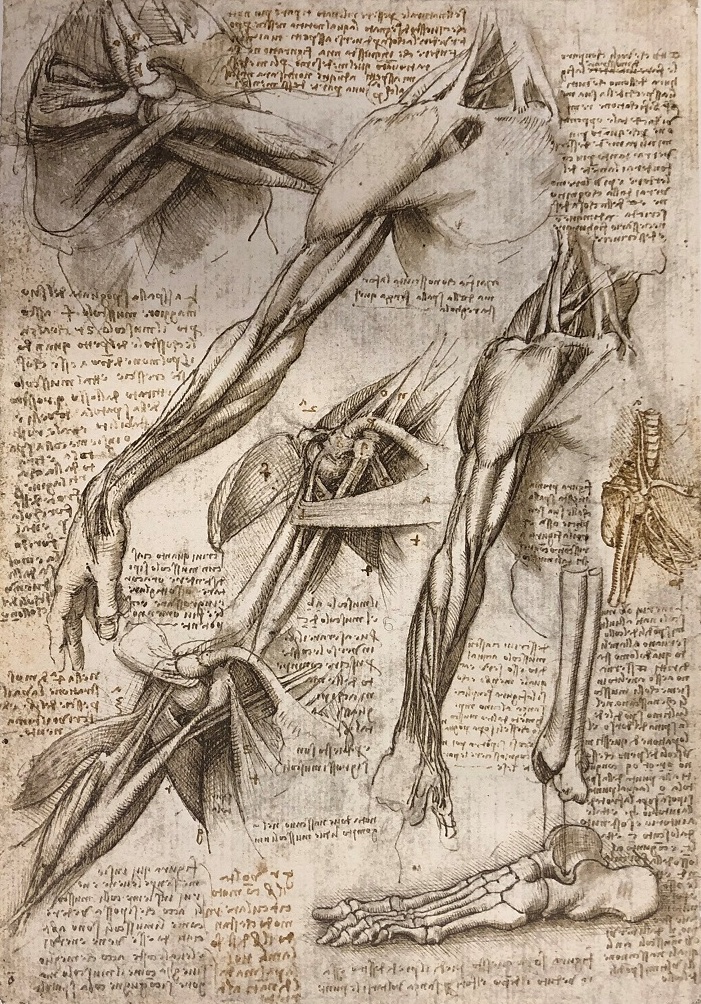 Artists such as Leonardo drew from dissections to better understand the underlying structure of the body and the mechanics of the human figure. Since this time, drawing from the nude has been the bedrock of an artist’s training, and the study of human anatomy continues to be an essential part of that process.
Artists such as Leonardo drew from dissections to better understand the underlying structure of the body and the mechanics of the human figure. Since this time, drawing from the nude has been the bedrock of an artist’s training, and the study of human anatomy continues to be an essential part of that process.
In this two-week workshop, you will draw daily from the live model, improving your ability to see line, proportion and form. You will also study human anatomy in depth, utilizing the rich collection of resources available at the ICA. Your growing understanding of anatomy will enable you to draw contours and render values with a greater degree of accuracy. In short, you will learn to draw better figures.
Six centuries ago, in the Renaissance city of Florence, Michelangelo and Leonardo began the first in depth studies of anatomy since the ancient Greeks. The drawings they created remain among the most beautiful in Western art. You will have the unique opportunity to view original drawings by these masters and others up close during our visit to the Gabinetto dei Disegni at the Uffizi Gallery in Florence.
We will also take a day trip to Rome to visit the Capitoline Museum and the Palazzo Massimo, both of which house Greek sculptures considered the most magnificent ever created. The opportunity to observe and discuss these sculptures will enhance your understanding of anatomy and form, while also enriching your knowledge of the history of the figure in art.
Materials for the course will be available in the ICA Art Supply store in Monte Castello.
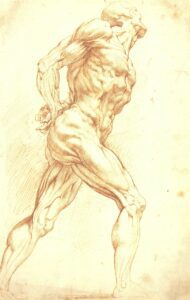 Participants will be housed in the remarkably well-preserved Umbrian hill town of Monte Castello di Vibio. Your workshop package is all-inclusive, providing welcome and departure services and airport transfer from the Rome Fiumicino, Leonardo Da Vinci Airport (FCO) aboard our comfortable private bus, single occupancy accommodations with shared bath (a wide range of upgrades with private bath are available), 3 meals per day Monday-Thursday, Prosecco brunch and dinner on Saturday and Sunday (no meals are served on Friday, our excursion day. Your workshop includes one excursion per week and many additional options are available on weekends for an additional fee. Of course, 24/7 access to facilities and 24/7 bi-lingual support are provided.
Participants will be housed in the remarkably well-preserved Umbrian hill town of Monte Castello di Vibio. Your workshop package is all-inclusive, providing welcome and departure services and airport transfer from the Rome Fiumicino, Leonardo Da Vinci Airport (FCO) aboard our comfortable private bus, single occupancy accommodations with shared bath (a wide range of upgrades with private bath are available), 3 meals per day Monday-Thursday, Prosecco brunch and dinner on Saturday and Sunday (no meals are served on Friday, our excursion day. Your workshop includes one excursion per week and many additional options are available on weekends for an additional fee. Of course, 24/7 access to facilities and 24/7 bi-lingual support are provided.
Dive into the captivating world of Italian wines with our immersive workshop on Italy's indigenous grape varieties! These autochthonous grapes are uniquely adapted to the specific soil, climate, and traditions of their region, resulting in wines that are truly distinctive. Italy is home to an impressive diversity of these grapes, with 545 officially registered varieties. Each one has its own unique flavor profile and a rich history that reflects Italy's deep-rooted winemaking heritage.
In recent years, Italian winemakers have been bringing back these nearly extinct grape varieties, creating wines that celebrate the authentic flavors of Italy's varied terroirs. In this workshop, you'll learn about these rare grapes and their fascinating histories, and, when possible, meet the passionate producers who are reviving them. We’ll provide printouts to enhance your learning experience, conduct tastings of these unique wines, and offer visits to Umbrian and Tuscan wineries
On the first day, you'll delve into the winemaking process, explore different types of terroir and their effects on wine, and learn how to properly assess wine using visual, olfactory, and gustatory senses, all under the guidance of a professional sommelier, whose knowledge of rare and ancient grapes is truly impressive. Even those familiar with the wines of Italy will discover a whole new dimension to Italian wine.
The workshop is led by renowned food and wine critic and sommelier, Rowena Dumlao. With her guidance, you'll explore wines from each of Italy's 20 regions. Rowena has meticulously selected 2 wines from each region, highlighting the country’s remarkable vinicultural diversity. Each day includes an informative presentation followed by a tasting session featuring 8 distinctive wines, allowing participants to sample over 50 different wines throughout the workshop.
A day-rate price of € 280 per day or € 950 for the week without meals or accommodation is available for local residents.
For guests staying with us as well as for day-visitors, the itinerary is as follows:
Monday, September 15, Wines of: Umbria, Abruzzo, Marche, Tuscany
Umbria
Abruzzo
Le Marche
Tuscany
Tuesday, September 16, Wines of: Trentino-Alto Adige, Valle d’Aosta, Friuli-Venezia Giulia, Veneto
Trentino-Alto Adige
Valle d’Aosta
Friuli -Venezia Giulia
Veneto
Wednesday, September 17, Wines of: Piemonte, Liguria, Emilia Romagna, Lombardia
Piedmonte
Liguria
Emilio Romagna
Lombardia
Thursday, September 18, Wines of : Campania, Lazio, Basilicata, Molise
Campania
Lazio
Basilicata
Molise
Friday, September 19,Wines of: Sicily, Sardegna, Puglia
Sicily
Sardegna
Puglia
Calabria
Saturday: September 20, Umbrian Vineyard visits
Throughout the week-long experience, participants will be housed in the remarkably well-preserved Umbrian hill town of Monte Castello di Vibio. The workshop package is all-inclusive, providing welcome and departure services and airport transfer from the Rome Fiumicino, Leonardo daVinci Airport (FCO). Aboard our comfortable private bus, single occupancy accommodations with spectacular views, 3 meals per day Monday-Thursday, Prosecco brunch and dinner on Saturday.
Of course, throughout your stay, 24/7 access to facilities and 24/7 bi-lingual support are provided.
This two-week workshop is designed for all skill levels from complete beginner to advanced ceramic makers. It will focus on exploring the ancient Italian renaissance ceramic technique of tin-glazed earthenware, or Maiolica. While housed at the ICA students will have the opportunity to work with ancient clay materials, to explore the use of figuration, and myth and allegory on tiles or small vessels. Through studio exploration, group lectures and discussions, as well as the unique opportunity to view and study Italian Maiolica in some of its most famous centers for manufacturing in Deruta and Orvieto, students will create objects that continue and expand upon the rich traditions of tin-glazed pottery and narrative, illustrative approaches to self-expression.
Participants will be housed in the remarkably well-preserved Umbrian hill town of Monte Castello di Vibio. Your workshop package is all-inclusive, providing welcome and departure services and airport transfer from the Rome Fiumicino, Leonardo Da Vinci Airport (FCO). Aboard our comfortable private bus, single occupancy accommodations with shared bath (a wide range of upgrades with private bath are available), 3 meals per day Monday-Thursday, Prosecco brunch and dinner on Saturday and Sunday (no meals are served on Friday, our excursion day. Your workshop includes one excursion per week and many additional options are available on weekends for an additional fee. Of course, 24/7 access to facilities and 24/7 bi-lingual support are provided.
 Experience some of the great mosaics treasures of the world and create your own mosaics!
Experience some of the great mosaics treasures of the world and create your own mosaics!
Rick Shelley's comprehensive, two-week mosaic workshop welcomes both beginning and advanced mosaic enthusiasts. Each week offers excursions to many magnificent treasures throughout Italy that will lead participants to a deeper understanding of mosaic arts.
Rick will teach you how to create mosaics. At our studios in Monte Castello, learn to shape stone, glass and ceramic into tesserae. Experiment with glues and cements to adhere tesserae onto wooden panels. Work with the beautiful and traditional practice of gold-leafing glass. Design and execute small mosaics using outlines, shadows and highlights - simple images, letters, or symbols are ideal subjects. You will learn first-hand, why mosaic is the most enduring form of pictorial art. From our central location in Italy, tour outstanding monuments and collections in Rome, Ravenna, Venice, and more. Visit mosaic schools and studios where you will meet Italian mosaic artists and study their techniques - all under the guidance of a master-mosaicist, Rick Shelley. (To see Rick in action, see his video:"Making mosaics in Italy"
Castello, learn to shape stone, glass and ceramic into tesserae. Experiment with glues and cements to adhere tesserae onto wooden panels. Work with the beautiful and traditional practice of gold-leafing glass. Design and execute small mosaics using outlines, shadows and highlights - simple images, letters, or symbols are ideal subjects. You will learn first-hand, why mosaic is the most enduring form of pictorial art. From our central location in Italy, tour outstanding monuments and collections in Rome, Ravenna, Venice, and more. Visit mosaic schools and studios where you will meet Italian mosaic artists and study their techniques - all under the guidance of a master-mosaicist, Rick Shelley. (To see Rick in action, see his video:"Making mosaics in Italy"
The two-week format of the workshop, allows participants three options: Week 1 only/ Week 2 only/ or - both Weeks.
On Saturday and Sunday, June 1 and 2, we have the extraordinary opportunity to visit the annual Infiorate of Spello. The Infiorate, is a festival held on the feast of Corpus Cristi. In Spello, the Infiorate is is a breathtaking event in which residents stay up all night on June 1, creating a wondrous "mosaic of flowers." Literally, the streets are covered with carpets of flower petals arranged in designs as well as images. (For wonderful insights into the festival and how these, "flower petal mosaics" come into being, see Michelle Damiani's wonderful website.) The fragile "tapestry" lasts only until June 2. With this schedule in mind, those in Week 1 only will attend the Saturday set up of the event. Those in Week 2, will be present for the procession through the streets of flowers. (Anyone wishing to add an extra day to a one week event, in order to experience both days of the Infiorate, may do so on a "day-rate" basis. Please contact us at: icarts.info@gmail.com for further info.)
Ravenna - a beautifully preserved city with monuments and mosaics from the 6th c. Here we will participate in a day-long workshop with demonstrations on the Ravenna Method.
Venice - where the magnificent church of San Marco, shimmers with mosaics inside and out. Here, we will visit the legendary Orsoni Furnace glassworks, and travel to the island of Murano to experience their incredible glassmaking traditions.
Cost of week 2 (including the Sunday ONLY Infiorate visit) is: € 3531
Both Weeks: The cost of BOTH, week-long workshops is: € 5950 and includes both Saturday and Sunday Infiorate visits.
Studio work in Monte Castello
Between these excursions, the International Center for the Arts provides the perfect atmosphere to experience the mosaic arts. Surrounded by the Italian countryside, the studio at Monte Castello di Vibio is an oasis in which to work and learn.All the while, participants will be housed in the remarkably well-preserved Umbrian hill town of Monte Castello di Vibio. Your workshop package is all-inclusive, providing welcome and departure services and airport transfer from the Rome Fiumicino, Leonardo Da Vinci Airport (FCO). Aboard our comfortable private bus, single occupancy accommodations with shared bath (a wide range of upgrades with private bath are available), 3 meals per day Monday-Thursday while in Monte Castello, Prosecco brunch and dinner on Saturday and Sunday (no meals are served on Friday, our excursion day. On the final day of the workshop, participants will exhibit their work in our, Bocca al Luppo gallery with opening reception provided. Of course, 24/7 access to facilities and 24/7 bi-lingual support are provided. All supplies are included.
Our Mosaics in Italy with Rick Shelley workshop is a rare opportunity to study with a master of the medium in a country renowned for some of its greatest examples. All the while, participants will enjoy a rare immersion in traditional culture, enjoy incredible views made possible by our mountaintop location, delight in gourmet and traditional food prepared fresh by expert chefs from fresh, locally sourced ingredients all accompanied by excellent local wine (or optional selections from our wonderful Wine List, for an additional fee). It is a rare experience, available to only 10 participants.
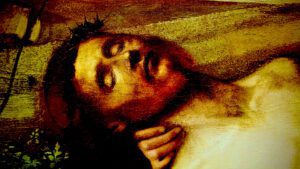 In the 14th c. Sicilian painter, Antonello di Messina brought the new medium of oil painting to Italy. In his travels, he brought the medium to Venice, where artists such as Giovanni Bellini, adopted, and expanded the expressive potential of the medium. Perhaps one of the most influential painting teachers in history, Bellini’s pupils included some of the greatest figures in the history of the medium: Titian, Tintoretto, and Veronese. Their often huge, operatic paintings mark a kind of crowning achievement for the medium, and the processes they developed consequently influenced other great artists and schools of art that included Caravaggio, Rembrandt, Velazquez and countless others who have followed in their path.
In the 14th c. Sicilian painter, Antonello di Messina brought the new medium of oil painting to Italy. In his travels, he brought the medium to Venice, where artists such as Giovanni Bellini, adopted, and expanded the expressive potential of the medium. Perhaps one of the most influential painting teachers in history, Bellini’s pupils included some of the greatest figures in the history of the medium: Titian, Tintoretto, and Veronese. Their often huge, operatic paintings mark a kind of crowning achievement for the medium, and the processes they developed consequently influenced other great artists and schools of art that included Caravaggio, Rembrandt, Velazquez and countless others who have followed in their path.
This workshop will follow the oil painting methods of the great Venetian masters. Working from reproductions, participants will reproduce easel-sized works of the Venetian school of the 16th-18th c. They may also choose to copy a detail from larger Venetian masterworks. To as great an extent possible, students will use the same materials of 15th and 16th c. Venetian artists, many of which will be prepared by hand in class, according to traditional recipes.
Beginning on a uniquely coarse, stretched canvas (approximately 36” x 30”) prepared with rabbit skin glue and white lead, participants will apply a colored ground. This rich, colored surface establishes an overall, atmospheric tonality, that also functions as a very useful neutral color. This then, serves as the basis for the serendipitous approach to color and the remarkable atmospheric effects that are unique to this school of painting.
On this rich surface, participants will transfer perforated drawings with charcoal and a pounce as was done in this time. Afterward, earth colors, carbon black, and white lead ground in oil will be prepared by the class. With these basic colors, an underpainting will be developed using alternating layers of washes and thick impasto areas of white lead. Afterward, rich layers of transparent colors made primarily from pigments produced in in our Pigments and Paint Workshop will be applied. In the process, students will develop an unders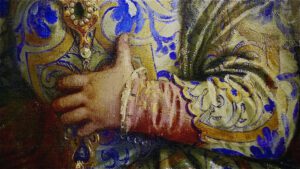 tanding of the important terms, glaze (a dark, thinned color over a lighter surface) and scumble (a thin layer of white lead) as they seek to reproduce the sumptuous color and dramatic brushwork characteristic of the Venetian School.
tanding of the important terms, glaze (a dark, thinned color over a lighter surface) and scumble (a thin layer of white lead) as they seek to reproduce the sumptuous color and dramatic brushwork characteristic of the Venetian School.
During the class participants will have the unique opportunity to see remarkable examples of work by the Venetian masters in person during our excursion to the Pitti Palace in Florence.
Throughout the workshop, participants will be housed in the remarkably well-preserved Umbrian hill town of Monte Castello di Vibio. Your workshop package is all-inclusive, providing welcome and departure services and airport transfer from the Rome Fiumicino, Leonardo Da Vinci Airport (FCO). Aboard our comfortable private bus, single occupancy accommodations with shared bath (a wide range of upgrades with private bath are available), 3 meals per day Monday-Thursday, Prosecco brunch and dinner on Saturday and Sunday (no meals are served on Friday, our excursion day. Your workshop includes an excursion to Florence. Of course, throughout your stay, 24/7 access to facilities and 24/7 bi-lingual support are provided.
Price of the workshop includes all materials needed to produce the painting described above, except brushes, which will be available for sale at ICA in Italy. While it is unlikely that the painting will be completed in the timeframe allowed by the workshop, our goal is to give participants a sufficient understanding of the Venetian process in order to complete the painting at home. As part of the course fee, participants will be issued a unique folding stretcher that allows the painting itself to be folded into a carry-on luggage-sized parcel, even if not fully dry.
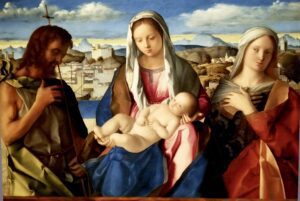 Oil painting developed in Northern Europe early in the 15th c. and Italian painters of the next generation quickly adopted the medium to their own unique vocabulary. Antonello di Messina is generally credited with the introduction of oil painting to Italy and more specifically, to Venice. Artists such as Giovanni Bellini, as well as Leonardo further expanded the expressive potential of the medium. The processes that these artists developed consequently influenced the whole history of Western Art.
Oil painting developed in Northern Europe early in the 15th c. and Italian painters of the next generation quickly adopted the medium to their own unique vocabulary. Antonello di Messina is generally credited with the introduction of oil painting to Italy and more specifically, to Venice. Artists such as Giovanni Bellini, as well as Leonardo further expanded the expressive potential of the medium. The processes that these artists developed consequently influenced the whole history of Western Art.
This workshop will follow their methods. Working from reproductions participants will use materials of the time, prepared by hand in a traditional way. Beginning on a wooden panel, prepared with rabbit skin glue and chalk gesso, participants will transfer their perforated drawings with charcoal and a pounce, then develop a wash drawing with genuine sepia ink, followed by an imprimatura – a colored “veil” - that establishes a tonality and a very useful neutral color. From here, oil paint ground in class will be used to develop the underpainting. Afterwards, rich glazes of transparent colors made primarily from pigments produced in in our Pigments and Paint Workshop.
Throughout the workshop, participants will be housed in the remarkably well-preserved Umbrian hill town of Monte Castello di Vibio. Your workshop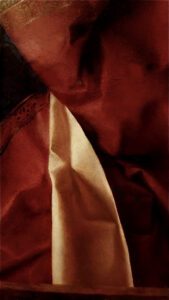
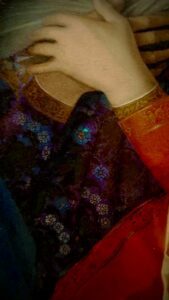
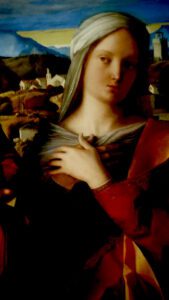 package is all-inclusive, providing welcome and departure services and airport transfer from the Rome Fiumicino,Leonardo Da Vinci Airport (FCO). Aboard our comfortable private bus, single occupancy accommodations with shared bath (a wide range of upgrades with private bath are available), 3 meals per day Monday-Thursday, Prosecco brunch and dinner on Saturday and Sunday (no meals are served on Friday, our excursion day. Your workshop includes an excursion to Perugia. Of course, throughout your stay, 24/7 access to facilities and 24/7 bi-lingual support are provided.
package is all-inclusive, providing welcome and departure services and airport transfer from the Rome Fiumicino,Leonardo Da Vinci Airport (FCO). Aboard our comfortable private bus, single occupancy accommodations with shared bath (a wide range of upgrades with private bath are available), 3 meals per day Monday-Thursday, Prosecco brunch and dinner on Saturday and Sunday (no meals are served on Friday, our excursion day. Your workshop includes an excursion to Perugia. Of course, throughout your stay, 24/7 access to facilities and 24/7 bi-lingual support are provided.
Price of the workshop includes all materials needed to produce the painting described above, except brushes, which will be available for sale at ICA in Italy. While it is unlikely that the painting will be completed in the timeframe allowed by the workshop, our goal is to give participants a sufficient understanding of the Northern Renaissance process in order to complete the painting at home. As part of the course fee, participants will be issued a unique case for the painting that allows the painting itself to be folded into a carry-on luggage-sized parcel even if not fully dry.
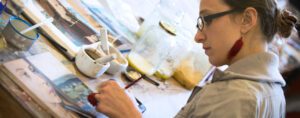 A hands-on workshop on producing painting and drawing materials according to historical methods. The intensive, week-long workshop is ideal for painters interested in gaining greater familiarity with their materials, academics and teachers interested in curricular development, art historians, and people interested in developing a deeper understanding of traditional works.
A hands-on workshop on producing painting and drawing materials according to historical methods. The intensive, week-long workshop is ideal for painters interested in gaining greater familiarity with their materials, academics and teachers interested in curricular development, art historians, and people interested in developing a deeper understanding of traditional works.
Born in 1360, painter Cennino d’Andrea Cennini, left a remarkable legacy, beyond that of his surviving works.
A student, of a student, of Giotto, Cennino left of us a remarkable and intimate record of the life and working processes of a painter in his time. His book is called, il Libro del’Arte, simply, “The Book of Art.” It provides insights into the training of the artists of his time, as well as that of the next generations of artists in Italy. Incredibly, this included some of the greatest figures in the history of Western painting: Masaccio, Fra Angelico, Leonardo, Botticelli, Michelangelo, and Raphael among others. To the reader of today, Cennini’s text provides the remarkable opportunity to participate in this legacy.
On a practical level, Cennini’s book is also a very useful guide to the production of pigments, paints, painting surfaces, and other materials of the medieval and Renaissance artist. In this however, it also reveals something larger than that of a recipe book. It speaks to a very special connection between artists and the materials they choose. Often, that connection resulted from artists making their materials themselves, by hand. Indeed, Cennini refers lovingly to the rare, almost spiritual beauty of, ultramarine blue to the easy, sensual qualities of a charcoal black as well as to their sometimes, tempestuous personalities of materials like, dragon’s blood!
What is revealed is a unique connection to the materials of the artist, in which all elements have significance. As translator, Daniel Thompson describes, “A very choice black was, and still is, made from peach stones; and almond shells were sometimes charred to produce another sort. To the outsider all these blacks would seem very much alike; indeed, they would probably be quite indistinguishable. But a painter of the medieval kind becomes familiar with the little quirks of personality in his pigments, and is affected by small subtleties which it is hopeless to try to define, subtleties not so much of color as of working quality, how the pigment feels, how it mixes, whether it tends to settle out of a color mixture, or stays nicely in suspension, and little things like that.” These “little things” can indeed have big effect to the artist who remains sensitive to the qualities of their materials, creating a bond that becomes a language of its own.
We will use Cennini’s book as a basis for our exploration of making pigments and paints. Guided by the experience of our staff, in collaboration with our long-time supplier, Kremer Pigmente, and the advantage of modern chemistry and production methods, we will embark on a historical overview of pigments used by artists throughout the ages - actually, making many pigments from raw ingredients. We will observe sometimes miraculous transformations in color, creating beautiful and luscious pigments that will last …forever. We will then turn these colored particles into a variety of paints, pastels, and charcoal. Our goal will be to produce the following materials which participants will take home with them at the end of the workshop:
20 g. Jars of pigment as follows:
3 ml. Jars of pigment as follows:
Inks as follow:
50 ml tubes of oil colors as follows:
20 ml jar of
Watercolors in natural mussel shell, as follows:
Pastels as follow:
In doing so, we will understand the processes of levigation, grading for optimal particle size, grinding, precipitation of lake colors, and many other processes. We will also make surfaces to be used in a variety of aqueous, solvent-based, and dry applications. At the end of the workshop, an excursion to the National Gallery of Umbria in Perugia, will provide real examples from Cennini’s time and later, which will illustrate both the beauty and the permanence of these materials.
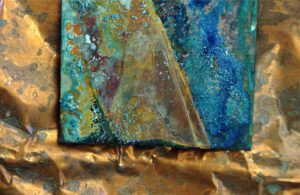 Participants will be housed in the remarkably well-preserved Umbrian hill town of Monte Castello di Vibio. Your workshop package is all-inclusive, providing welcome and departure services and airport transfer from the Rome Fiumicino, Leonardo Da Vinci Airport (FCO). Aboard our comfortable private bus, single occupancy accommodations with shared bath (a wide range of upgrades with private bath are available), 3 meals per day Monday-Thursday, Prosecco brunch and dinner on Saturday and Sunday (no meals are served on Friday, our excursion day. Your workshop includes one excursion per week and many additional options are available on weekends for an additional fee. Of course, 24/7 access to facilities and 24/7 bi-lingual support are provided.
Participants will be housed in the remarkably well-preserved Umbrian hill town of Monte Castello di Vibio. Your workshop package is all-inclusive, providing welcome and departure services and airport transfer from the Rome Fiumicino, Leonardo Da Vinci Airport (FCO). Aboard our comfortable private bus, single occupancy accommodations with shared bath (a wide range of upgrades with private bath are available), 3 meals per day Monday-Thursday, Prosecco brunch and dinner on Saturday and Sunday (no meals are served on Friday, our excursion day. Your workshop includes one excursion per week and many additional options are available on weekends for an additional fee. Of course, 24/7 access to facilities and 24/7 bi-lingual support are provided.
All materials for the class and the excursion are included in the cost of the workshop.
We will explore the expressive potential of the "Cabinet of Curiosity," or "Wunderkammer" in making our own "cabinet," inspired by visits to mysterious and wondrous sites in Central Italy.
In creating our own cabinet of curiosities, we will explore the way that this enigmatic format conjures an evocative sense of place, through the inspiration of visits to remarkable places in Central Italy. We will see enormous stone monsters from the 16th c., mummies, marble serpents devouring the souls of the damned, huge mosaic and glass sculptures - all the while collecting fragments of these experiences in order to make our own "memory - theatre"
Places of Wonder:
Italy is steeped in history and legends. Myth and religion animate the land with endless places of wonder. Mountaintops host mysterious castles, bridges recall lost loves and battles won, and woodedglades conceal ancient temples. Across the Italian landscape, churches and shrines honor many saints and miracles, and monuments celebrate the beautiful as well as the grotesque. Mannerist gardens with grottos and statuary still evoke a liminal place between reality and dreams.Throughout time, travelers have visited Italy to enrich their faith, seek inspiration, and marvel at the wealth of wonders created by a people of limitless curiosity.

Cabinets of Wonder

Marco Polo returned from China and India with exotic tales and objects. Amerigo Vespucci described strange and marvelous creatures across the seas. Leonardo dissected thehuman body and marveled at its complexity. Galileo pondered the heavens with telescopes and other instruments. Travelers, explorers, artists, and scientists fostered new knowledge that overwhelmed. To understand an ever-expanding world, Italy established the first European museums. These earliest museums began with collectors acquiring oddities – natural and man-made – to be displayed in cabinets later known as Wunder Kammer. Emerging in the 16th c., these "wonder-rooms" or "wonder cabinets,' were filled with preserved animals, coral, tusks, skeletons, minerals, as well as exotic, man-made objects - "a wide variety of objects and artifacts, with a particular leaning towards the rare, eclectic and esoteric." They "were regarded as a microcosm or theatre of the world - and a memory theatre."
Our Workshop
During the week, we will be inspired by visits to the Sacro Bosco also known as the Park of the Monsters in Bomarzo, Etruscan tombs, the Teatrum Mundi, the Tarot Garden and more. We will also hunt for modestly -priced treasures at local shops and antique markets. At the studio in Monte Castello, participants will be encouraged to create their own Wunder Kammer by making a small shrine, box, or cabinet to contain venerated objects or display a personal collection of curiosities accumulated on our adventures or brought from home..
 Throughout the workshop, participants will be housed in the remarkably well-preserved Umbrian hill town of Monte Castello di Vibio. Your workshop package is all-inclusive, providing welcome and departure services and airport transfer from the Rome Fiumicino, Leonardo Da Vinci Airport (FCO). Aboard our comfortable private bus, single occupancy accommodations with shared bath (a wide range of upgrades with private bath are available), 3 meals per day Monday-Thursday, Prosecco brunch and dinner on Saturday and Sunday (no meals are served on Friday, our excursion day. Your workshop includes one excursion per week and many additional options are available on weekends for an additional fee. Of course, 24/7 access to facilities and 24/7 bi-lingual support are provided.
Throughout the workshop, participants will be housed in the remarkably well-preserved Umbrian hill town of Monte Castello di Vibio. Your workshop package is all-inclusive, providing welcome and departure services and airport transfer from the Rome Fiumicino, Leonardo Da Vinci Airport (FCO). Aboard our comfortable private bus, single occupancy accommodations with shared bath (a wide range of upgrades with private bath are available), 3 meals per day Monday-Thursday, Prosecco brunch and dinner on Saturday and Sunday (no meals are served on Friday, our excursion day. Your workshop includes one excursion per week and many additional options are available on weekends for an additional fee. Of course, 24/7 access to facilities and 24/7 bi-lingual support are provided.
.
The study of human anatomy in Italy is a long and distinguished tradition. The extraordinary anatomical theatres in medical schools at the University of Padua and the University of Bologna bear witness to this history and were among the first of their kind in existence. Even today, we marvel at the accuracy and lifelike intensity of the 17 th c. wax anatomical models in the Specola Museum in Florence, which were made to allow medical students to observe venous, muscular, and skeletal systems without a cadaver. In this regard, the study of anatomy in Italy has profoundly impacted not only our understanding of the human body, but also the study of medicine in the western world.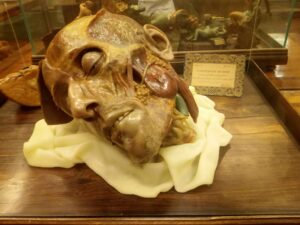
Surprisingly, this history also reveals much about the significance of the role of visual art in furthering science and medicine. In his brilliant series of lectures at the Art Students League in New York, artist, anatomist, and scholar, Robert Beverly Hale once said: “science had actually sprung from art, that it had developed in those great periods when artists had looked at nature very closely and carefully, and had tried to record exactly what they saw. That, what we explained, was what scientists have been doing ever since.”
To support Hale’s observation one need look no further than Leonardo’s anatomical studies. These drawings are incredible not only for their accuracy and beauty as works of art, but also as a highly accurate analysis of function, of what anatomist George Bridgeman referred to as “the human machine.” Leonardo is perhaps unequalled in his analysis of the form of the human body as a manifestation of the interrelationship of functioning systems. It is known, for example that Leonardo once injected the heart of an ox with hot wax, then made a glass model of the casting. He then pumped the model with water to analyze the circulation of fluids in the human heart. Incredibly, Leonardo’s conclusions were not fully corroborated by cardiologists until the 1980’s.
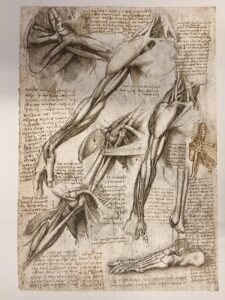 The objective of our Human Anatomy intensive is to follow in this tradition. Thus, we will not only identify anatomical structures of the human body, but we will also analyze the function of those structures and their effect on its outward form. Throughout the workshop, we will reference functional systems in understanding their manifestation in surface anatomy of the figure.
The objective of our Human Anatomy intensive is to follow in this tradition. Thus, we will not only identify anatomical structures of the human body, but we will also analyze the function of those structures and their effect on its outward form. Throughout the workshop, we will reference functional systems in understanding their manifestation in surface anatomy of the figure.
Our focus will be on the skeletal and muscular systems, with some analysis of the major arteries of the venous system. We will work from a variety of sources, including real human skeletons as well as drawing from our collection of anatomical models and plaster casts. Our medium in the course will be various drawing media in large-format sketchbooks as a means of note taking for the course.
Our approach will be in the form of lectures and hands on drawing focusing first on the skeletal system. We will draw from real human skeletons as well as anatomical models. We will explore one area of the body at a time, first in analyzing the skeletal structure of the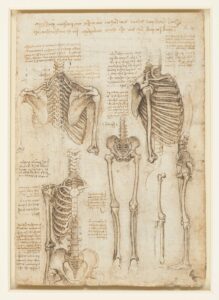 torso. Afterward, we will move on to the head, arms, and legs, as well as hands, and feet. Participants will produce life-sized drawings with charcoal on heavy paper as well as drawings in sketchbooks of details such as joint articulations.
torso. Afterward, we will move on to the head, arms, and legs, as well as hands, and feet. Participants will produce life-sized drawings with charcoal on heavy paper as well as drawings in sketchbooks of details such as joint articulations.
Afterward, the course will focus on the muscular system first through lecture and note-taking then by drawing from anatomical models, plaster casts, and the live model, in the same order. However, we will in exploring the muscular system we will utilize tracing paper and colored pencil, in order to add layers of muscles over our previous skeletal drawings.
In addition to the intensive schedule of daily drawing and lecture, we will make an excursion to the famed Specola Museum in Florence where we will draw from their collection of 16 th to 18th c. wax anatomical sculptures. The incredibly lifelike flayed figures are shockingly lifelike - at once factual and at the same time, powerfully expressive. Here, the wax models will provide an overview of the skeletal and muscular systems as well as an introduction to the venous system.
Throughout the workshop, participants will be housed in the remarkably well-preserved Umbrian hill town of Monte Castello di Vibio. Your workshop package is all-inclusive, providing welcome and departure services and airport transfer from the Rome Fiumicino, Leonardo Da Vinci Airport (FCO). Aboard our comfortable private bus, single occupancy accommodations with shared bath (a wide range of upgrades with private bath are available), 3 meals per day Monday-Thursday, Prosecco brunch and dinner on Saturday and Sunday (no meals are served on Friday, our excursion day. Your workshop includes one excursion per week and many additional options are available on weekends for an additional fee. Of course, 24/7 access to facilities and 24/7 bi-lingual support are provided.
Italy is synonymous in many minds with olive oil and it has traditionally produced some of the finest in the world! Here, in Umbria - the region called the Green Heart of Italy - a land of olive trees, grape vines, wheat fields, and rich in ancient traditions - we are very fortunate to produce some of the finest oils in Italy. Our little village is surrounded by olive orchards in every direction and their yield has claimed numerous regional and national awards. This Green-Gold as it is sometimes called, is the pride of our region and our locality. Those who have never experienced the flavor of freshly-pressed Umbrian pure virgin olive oil will be amazed by the complex flavor: smelling of the green of freshly cut grass, then rich and buttery, and finally - a spicy finish - it is among the most complex oils in the world!
From our mountain castle village, we are fortunate to be within a mornings walk of Passo del Palomba, a farm estate owned by Alessandro Gilotti and his wife, Claudia. Sandro is an internationally renowned expert on olive oil, and owner of one of the most highly-regarded producers in the region. The couples passion for this land as well as for the oil and wine they produce, is infectious and participants will soon be won over by their enthusiasm for the health benefits of his oil and his vast knowledge of cultivation and production.
The course is designed for all levels of interest, those with a general interest in simply learning more about quality olive oil in spectacularly beautiful setting will be equally enriched by the workshop as those with careers in the culinary arts, seeking to enhance their expertise and credentials. The week-long workshop, will consist of four, three-hour classes, held on the farm of the Passo del Palomba estate from Monday to Thursday. Day-five will be held at our Asilo facility, where we will do a tasting paired with dinner, accompanied by local wines of note. Afternoons will be spent in Monte Castello with excursions to local wineries, food and wine tastings, and a truffle hunt.
Topics to be addressed in our time at Passo della Palomba: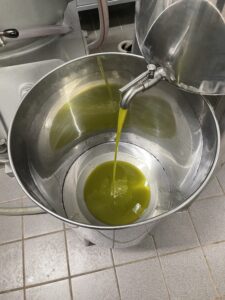
During your stay, you will be housed at a beautiful and grand, 17th c. villa, located on a forested mountain overlooking Tiber valley.
Surrounded on all-sides by olive groves, carefully kept lawns and grand cypress trees, hedges of lavender and rosemary grace the landscape, with a vegetable garden for guest use - the setting is idyllic. The stately villa itself is completely gated and fenced and features unique architectural elements, such as beautifully painted beamed and brick domed ceilings, terracotta tiled floors, stone walls, unique fireplaces, arched doorways and wooden-shuttered windows, all complemented by the stylish furnishing and decor throughout. The designer kitchen features the most elegant contemporary appliances and features.The main house sleeps ten (four bedrooms, all en-suite). In addition, a stone cottage and sleeps 4 in 2 bedrooms, with a separate bathrooms, and provides several sitting and relaxation areas in addition to a very comfortable main lounge. A large upper terrace includes a shaded area, perfect for dining and appreciating spectacular sunsets and mountain views. The lower patio surrounds a magnificent infinity pool. The villa is a stunning property that will provide unforgettable experiences and memories that will last a lifetime.
F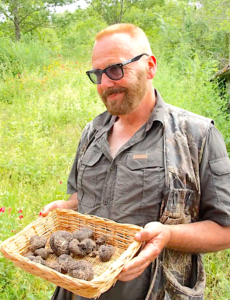 or those interested in a full gastronomic immersion in traditions of food and wine of Italy, this week-long workshop is ideal! Set in the geographic center of Italy - the region of Umbria, is known as the "green heart" of Italy. Here in a small medieval village set among the verdant hills of the Todi valley, a full immersion in ancient knowledge and traditional flavors will take place. Oenophiles interested in discovering the wines of the region will not be disappointed - surrounded by by world-class vineyards in every direction, there will be plenty of opportunities for discovering the excellent wines of the region!
or those interested in a full gastronomic immersion in traditions of food and wine of Italy, this week-long workshop is ideal! Set in the geographic center of Italy - the region of Umbria, is known as the "green heart" of Italy. Here in a small medieval village set among the verdant hills of the Todi valley, a full immersion in ancient knowledge and traditional flavors will take place. Oenophiles interested in discovering the wines of the region will not be disappointed - surrounded by by world-class vineyards in every direction, there will be plenty of opportunities for discovering the excellent wines of the region!
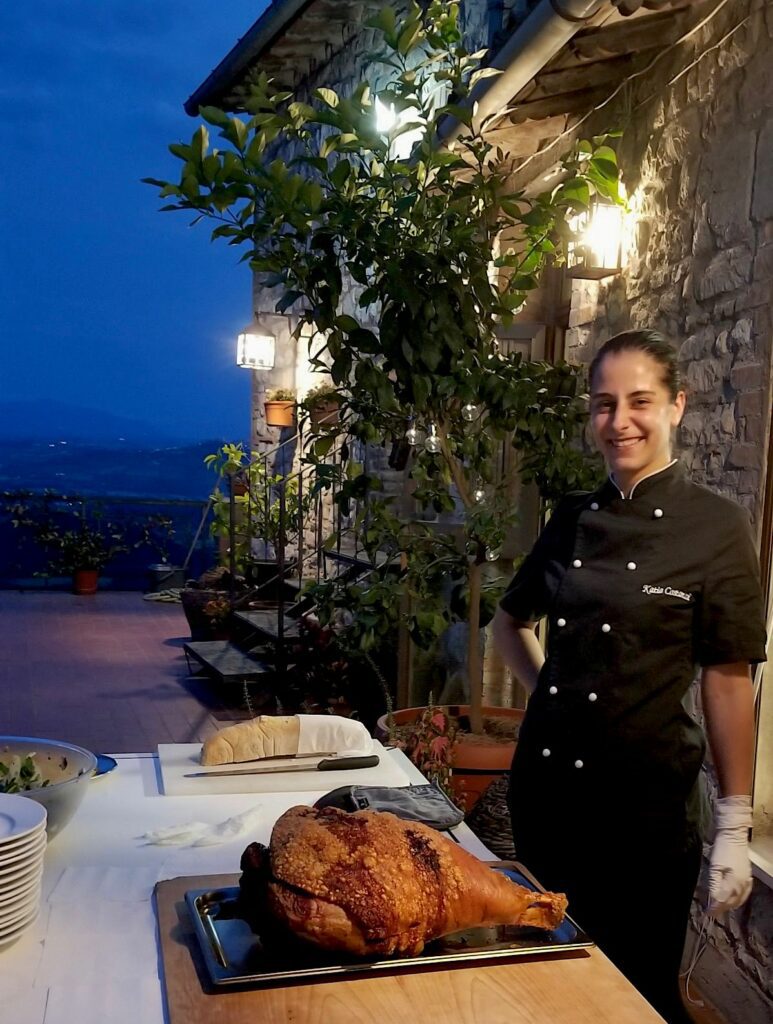
Intended for experts or enthusiasts in the food and wine sector interested in improving their skills, those interested in learning about Italian foodand wine for personal pleasure, or simply for enthusiasts of good living - the pleasures of the Umbrian table provide for an unforgettable experience in Italy.
The duration of the workshop is one week, from 4 to 11 May 2024. (There is also a possibility of personalized dates on request, if an already formed group of 6 - 12 presents itself with different time needs.)
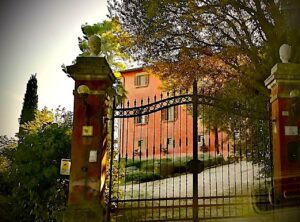
During your stay, you will be housed at a beautiful and grand, 17th c. villa, located on a forested mountain overlooking Tiber valley. Surrounded on all-sides by olive groves, carefully kept lawns and grand cypress trees, hedges of lavender and rosemary grace the landscape, with a vegetable garden for guest use - the setting is idyllic. The stately villa itself is completely gated and fenced and features unique architectural elements, such as beautifully painted beamed and brick domed ceilings, terracotta tiled floors, stone walls, unique fireplaces, arched doorways and wooden-shuttered windows, all complemented by the stylish furnishing and decor throughout. The designer kitchen features the most elegant contemporary appliances and features.The main house sleeps ten (four bedrooms, all en-suite). In addition, a stone cottage and sleeps 4 in 2 bedrooms, with a separate bathrooms, and provides several sitting and relaxation areas in addition to a very comfortable main lounge. A large upper terrace includes a shaded area, perfect for dining and appreciating spectacular sunsets and mountain views. The lower patio surrounds a magnificent infinity pool. The villa is a stunning property that will provide unforgettable experiences and memories that will last a lifetime.
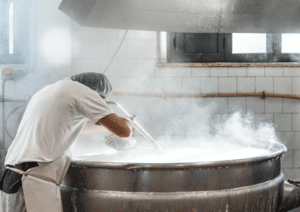 Daily cooking classes will be held by a local chef in English or Italian (if requested), with years of experience in the food and wine sector. Wine tastings add appreciation will be directed by a 3rd level sommelier, and the farms and woodlands will enrich the palette of event the most knowledgable connoisseurs of cheeses along with - the green gold of Umbria - its wondrously rich and flavorful olive oil for which the region is famous - and 0f course, the black and white truffles of Norcia, which will be used in many of the traditional recipies and preparations, we will explore. Guided by typical recipes of Umbrian cuisine, peasant traditions, and ancient flavors will be enriched by the backdrop castles and ancient village set among the verdant woodlands of the region. The workshop presents a full immersion in the food and wine culture of Italy, which will mark your way of knowing food, tasting it, and experiencing it!
Daily cooking classes will be held by a local chef in English or Italian (if requested), with years of experience in the food and wine sector. Wine tastings add appreciation will be directed by a 3rd level sommelier, and the farms and woodlands will enrich the palette of event the most knowledgable connoisseurs of cheeses along with - the green gold of Umbria - its wondrously rich and flavorful olive oil for which the region is famous - and 0f course, the black and white truffles of Norcia, which will be used in many of the traditional recipies and preparations, we will explore. Guided by typical recipes of Umbrian cuisine, peasant traditions, and ancient flavors will be enriched by the backdrop castles and ancient village set among the verdant woodlands of the region. The workshop presents a full immersion in the food and wine culture of Italy, which will mark your way of knowing food, tasting it, and experiencing it!
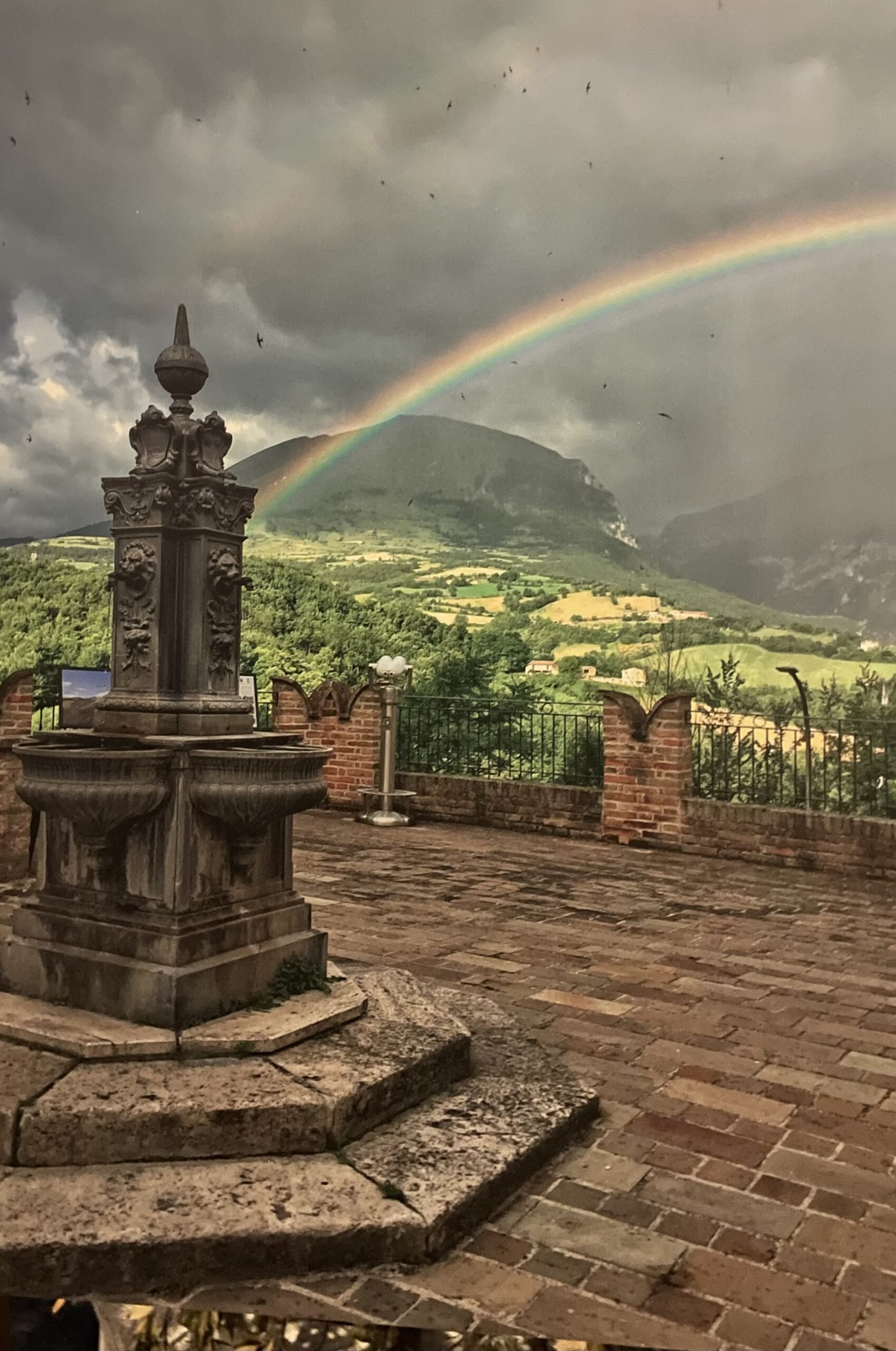 Of Sibyls and Source: Performance in the Landscape is a two-week exploration of live art in geo-mythic sites in Umbria.
Of Sibyls and Source: Performance in the Landscape is a two-week exploration of live art in geo-mythic sites in Umbria.
This residency aims to open space for research,inquiry, and connection through myth making and embodied presence in/with/of the land. We will spend 3 days hiking in the Parco Nacional di Sibilline, part of the Apennines named for the Sibyl, or prophetess of antiquity, who is believed to have lived there in a cave at the top of Monte Sibilla. We will experience sites of ritual and esoteric rites related to the myth of the Sibyl mentioned in literary sources as well as living local folk traditions dating back thousands of years. Our time together will also include day trips to the Nera river with Roman ruins whose source is the Monti Sibillini and entrance into the remarkable Frassasi cave.
Performances may take place at any or all of these locations including the impeccably maintained medieval town of Monte Castello di Vibio, our home base. At the conclusion of the residency we will hold a screening and live performance event in Monte Castello di Vibio. Our group will include a videographer to help document our work.
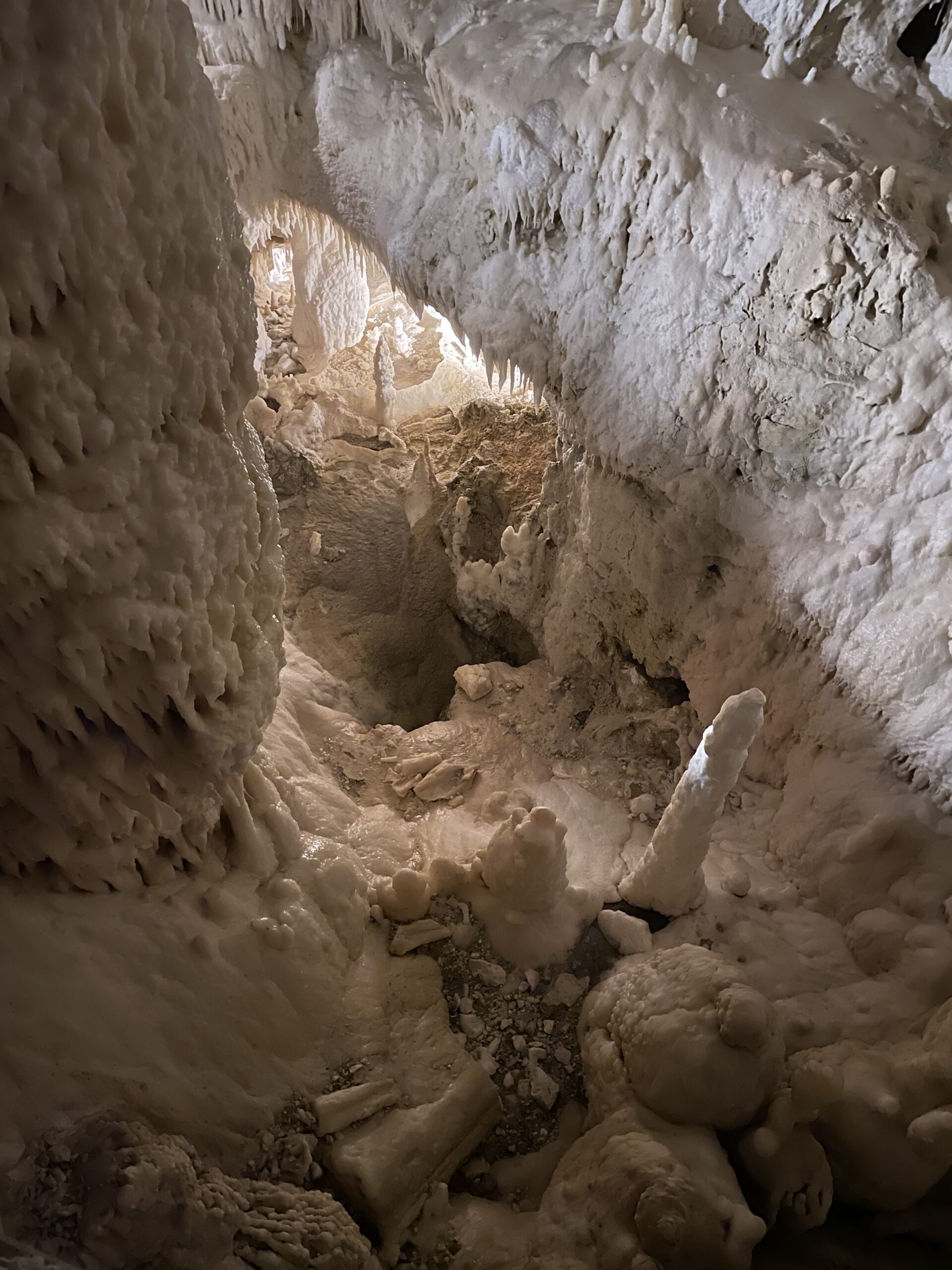 Please note this residency includes physical complexities: moderate hiking up to an altitude of 7654 ft (2333 m), cold-water wild swimming and a cave visit. Applicants are responsible for their own physical wellbeing. Please submit project proposals related to Parco Nacional di Sibilline, Nera river and Frassasi cave for consideration. Thus, due to the unique, logistical and locational considerations, a brief Project Proposal (of approximately 300 words) is required for this workshop. Please submit this, as well as a current CV and images of work (or link to a website) via email at: icarts.info@gmail.com Responses will be issued within 48 hours.
Please note this residency includes physical complexities: moderate hiking up to an altitude of 7654 ft (2333 m), cold-water wild swimming and a cave visit. Applicants are responsible for their own physical wellbeing. Please submit project proposals related to Parco Nacional di Sibilline, Nera river and Frassasi cave for consideration. Thus, due to the unique, logistical and locational considerations, a brief Project Proposal (of approximately 300 words) is required for this workshop. Please submit this, as well as a current CV and images of work (or link to a website) via email at: icarts.info@gmail.com Responses will be issued within 48 hours.
Participants will be housed in the remarkably well-preserved Umbrian hill town of Monte Castello di Vibio. Your workshop package is all-inclusive, providing welcome and departure services and airport transfer from the Rome Fiumicino, Leonardo Da Vinci Airport (FCO), aboard our comfortable private bus; single occupancy accommodations with shared bath (a wide range of upgrades with private bath are available); 3 meals* per day, when on campus, Monday-Thursday; Prosecco brunch and dinner on Saturday and Sunday (when on campus) No meals are served on Friday - our excursion day - unless previously arranged. Your workshop includes the excursions below, however, many additional options are available for an additional fee. Of course, 24/7 access to facilities and 24/7 bilingual support are provided. *Meal service is provided while in Monte Castello only, unless otherwise noted. Meals on excursions and admissions are not included in the cost, unless specifically noted in the itinerary.
About our Videographer
 Born in Puerto Rico (1986) and based in Miami, misael soto’s practice interrogates and subverts contextually associated everyday objects and systemic roles, disrupting and manipulating space, systems, and frameworks. The publicly accessible, time-based, and ephemeral work involves interventions made upon existing objects, performative activations, institutional mediations, and is often a combination of these elements. misael received their MFA from the School of the Art Institute of Chicago (2018) and graduated Magna Cum Laude with a Bachelor's Degree in Art History from Florida Atlantic University (2008). misael was the first ever Art in Public Life Resident with the City of Miami Beach's Department of Environment and Sustainability and Oolite Arts, where they founded the Department of Reflection. Beyond their public artworks which they have shown extensively for many years, misael has exhibited at MCA Chicago, Open Engagement 2015, the Museum of Contemporary Art in North Miami, Material Art Fair in Mexico City, David Castillo Gallery in Miami, and Museum of Art Fort Lauderdale, amongst others.
Born in Puerto Rico (1986) and based in Miami, misael soto’s practice interrogates and subverts contextually associated everyday objects and systemic roles, disrupting and manipulating space, systems, and frameworks. The publicly accessible, time-based, and ephemeral work involves interventions made upon existing objects, performative activations, institutional mediations, and is often a combination of these elements. misael received their MFA from the School of the Art Institute of Chicago (2018) and graduated Magna Cum Laude with a Bachelor's Degree in Art History from Florida Atlantic University (2008). misael was the first ever Art in Public Life Resident with the City of Miami Beach's Department of Environment and Sustainability and Oolite Arts, where they founded the Department of Reflection. Beyond their public artworks which they have shown extensively for many years, misael has exhibited at MCA Chicago, Open Engagement 2015, the Museum of Contemporary Art in North Miami, Material Art Fair in Mexico City, David Castillo Gallery in Miami, and Museum of Art Fort Lauderdale, amongst others.
